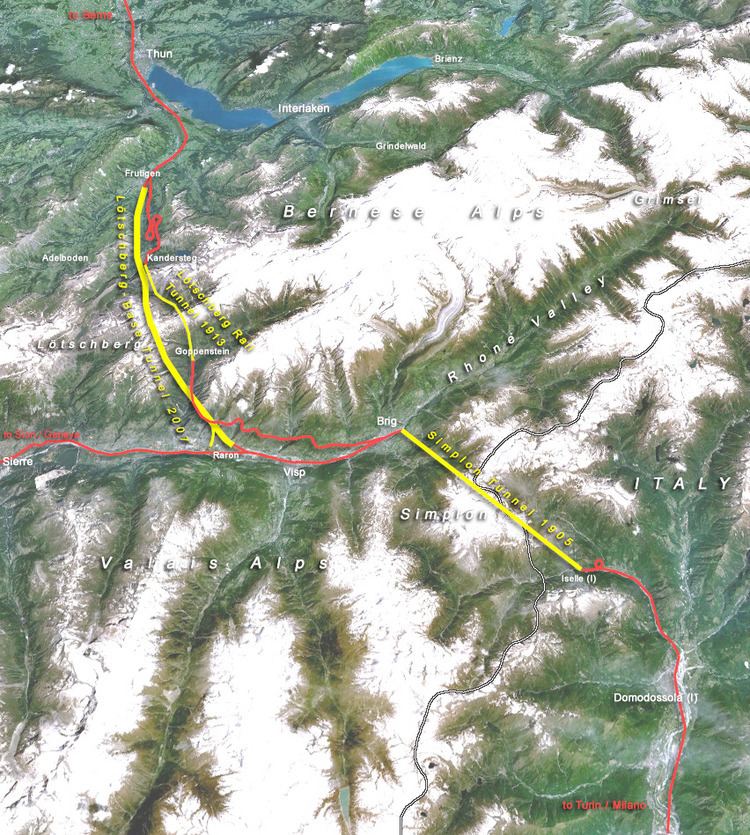Work begun 5 July 1999 Phone +41 27 934 19 12 | System BLS, SBB CFF FFS Opened 14 June 2007 | |
 | ||
Electrified 15 kV AC railway electrification Similar Lötschberg Tunnel, Gotthard Base Tunnel, Lötschberg, Simplon Tunnel, Alps | ||
The Lötschberg Base Tunnel (LBT) is a 34.57-kilometre (21.48 mi) railway base tunnel on the BLS AG's Lötschberg line cutting through the Bernese Alps of Switzerland some 400 m (1,312 ft) below the existing Lötschberg Tunnel. It runs between Frutigen, Berne, and Raron, Valais. Breakthrough was in April 2005 and construction ended in 2006. The opening ceremony was in June 2007. Full scale operation began in December 2007.
Contents
Project
Built to ease lorry traffic on Swiss roads, the LBT allows an increased number of lorries and trailers to be loaded onto trains in Germany, pass through Switzerland on rail and be unloaded in Italy. It also cuts down travel time for German tourists going to Swiss ski resorts and puts the Valais into commuting distance to Bern by reducing travel time by 50%. The total cost was SFr 4.3 billion (as of 2007, corrected to 1998 prices). This and the Gotthard Base Tunnel are parts of the Swiss AlpTransit initiative.
Construction and usage
Track construction in the LBT was completed in July 2006. Extensive testing then took place, including more than 1,000 test runs, which focused among other things on the use of the ETCS Level 2 system. For the second half of 2007 (after opening), only regular freight used the LBT, plus some international and InterCity passenger trains (without stops between Spiez and Brig); however, passenger trains used the old timetable (the travel time between Spiez and Brig was considered to be 56 minutes until December 2007, even if actual travel time through the LBT was only about 30 minutes).
Since February 2008, the LBT has been used for normal InterCity routes. Travel time between Visp and Spiez is about 28 minutes (about 16 minutes in the LBT).
Completion status
Due to the soaring costs of the overall AlpTransit initiative, funds were diverted from the Lötschberg tunnel to the Gotthard Base Tunnel; and the LBT is only half finished. The fully complete LBT will consist of two single track bores side by side from portal to portal, connected about every 300 metres (984 ft) with cross cuts, enabling the other tunnel to be used for escape.
Currently from South to North a third of the tunnel is double track, a third is single track with the second bore in place but not equipped, and a third is only a single track tunnel with the parallel exploration adit providing the emergency egress. The construction was divided into 3 phases with only phase 1 completed to date:
Phases 2 and 3 may be done together. Completing the LBT is estimated to cost 1 billion Swiss francs. The project also includes two parallel bridges over the Rhône river in canton Valais, the 2.6 km (1.6 mi) Engstlige tunnel (built with cut-and-cover method; the 2 tracks are separated by a wall).
Operation
About 110 trains per day use the LBT, and 66 use the old mountain tunnel because the single track severely limits the capacity of the base tunnel. Of the 110, 30 are passenger and 80 are freight, including both intermodal freight transport and long-distance heavy freight trains. Heavy freight trains up to a maximum weight of 4,000 tons and a maximum length of 1,500 metres have to use the LBT, as they cannot use the existing mountain track.
The 21 km of single track without passing loops complicate operations, and trains are scheduled by batches in each direction separated by long intervals; trains more than 7 minutes late are either routed via the old line or must wait for the next available timetable slot in their direction in the LBT, incurring further delay in either case.
Travel speeds
Geothermal energy
The warmth of the water flowing out of the tunnel is used to heat the Tropenhaus Frutigen, a tropical greenhouse producing exotic fruit, sturgeon meat and caviar.
